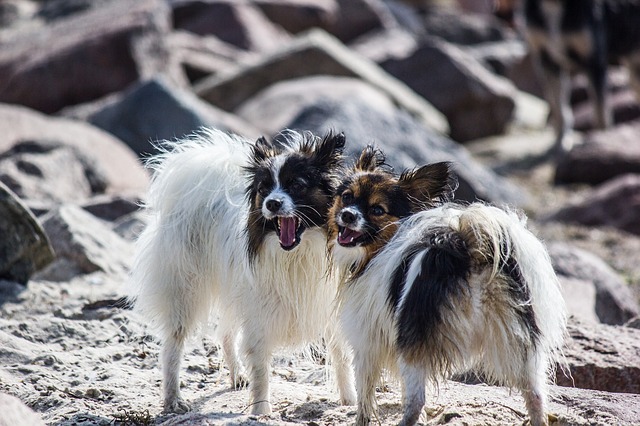A female dog in heat often experiences several symptoms, and one symptom that is often unnerving for dog owners to watch is crying and whining.
Seeing a dog cry or whine during the heat phase not only makes dog owners worry that something is terribly wrong somewhere but also wonder whether dogs get cramps.
So, do dogs get cramps on their periods (when they are in heat)?
We’ll find out shortly…
First Things First, What Causes Period Cramps in Humans?
According to naturalcycles.com, period cramps (or Dysmenorrhea) are caused by hormone-like substances (prostaglandins), which cause the female uterus walls to contract and shed its lining, resulting in periods.
A high level of prostaglandins is what’s often associated with cramps.
So, cramps are simply signs of a female body reacting to the natural process of shedding of the uterus walls.
Other conditions can also cause cramps, including lining forming outside the uterus (endometriosis), tissue linings growing into uterine walls (adenomyosis), uterine fibroids (non-cancerous growths on the uterus), pelvic inflammatory diseases, and cervical stenosis.
Cramps in Dogs
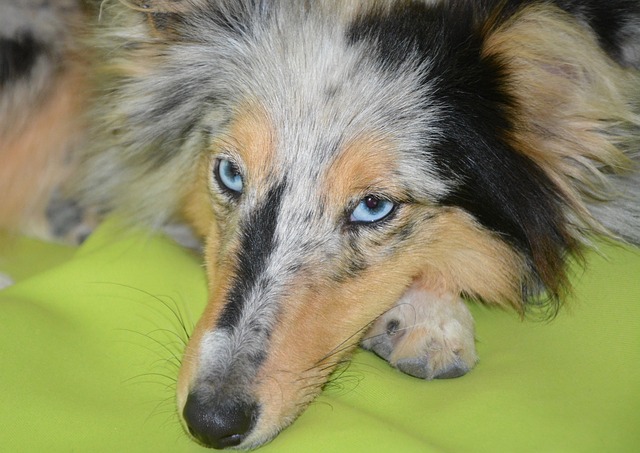
While dogs are physically different from humans, it is important to understand that some reproduction processes in dogs are quite similar to humans.
For instance, an egg is released and if it is fertilized, it will settle in the uterus and later become the female dog’s offspring.
The female dog heat cycle also bears many signs that are comparable to a woman’s menstrual cycle.
Accordingly, it is possible to assume that dogs get uncomfortable during their heat cycles and may even experience cramps.
Although we are not yet able to accurately read the minds of our pets, it is generally agreed that the discomfort felt by some female dogs while in heat is not very different from the discomfort humans feel during their menstrual cycle.
Presumably, the cramping caused by the contraction of the uterine walls in humans may be present in dogs as well.
Not ‘Cramps’ In the Real Sense of the Word…
In reality, however, it is not ‘cramps’ in the real sense of the word because our reproductive system works differently from that of dogs.
In humans, a period usually signifies an end of a cycle—it means that an egg was released, unfertilized, and the uterus linings are being shed for a fresh start of a new menstrual cycle. In other words, the onset of a period in humans is suggestive of a phase of infertility.
On the other hand, bleeding in dogs (or period) signifies the beginning of a heat cycle.
Put simply, it is an indication that a female dog is preparing to become receptive and possibly get pregnant.
So, dogs are not shedding off their uterine linings during their period (which is often the main cause of cramps in humans). Dogs tend to reabsorb the linings instead of getting rid of them.
In fact, unlike bleeding in humans whose main purpose is to get rid of the shed uterine linings, bleeding in dogs is a result of estrogen hormone triggering the uterus blood vessels to become highly permeable.
The red blood vessels then leak through a process known as diapedesis and cause the bloody discharge noted by dog owners.
Generally, diapedesis is more of a passive process than an active one and entails blood leaching through—no muscle contraction and spasm nor cramping or discomfort.
Discomfort Could Be Due To a Variety of Reasons
To this end, we can argue that if at all dogs experience discomfort while in heat, it could be due to some other reasons—other than the cramps we are familiar with in humans.
And one of the most probable causes is hormonal changes. Most experts agree that discomfort during heat could be caused by hormonal surges considering that it is common at the start of a menstrual cycle in dogs.
During a heat cycle, a wide range of female dog hormones work together and their balance is responsible for several changes in a dog’s body.
The hormones can leave your pup feeling tired, irritable, scared, lonely, and more—depending on her breed, personality, and whether or not it’s her first cycle.
Crying or whining when a dog is in heat can also serve as a “mating call” to male dogs.
Considering that dogs only get interested in sexual activities as means of propagating their species, the whining, moaning, crying, and any behavior that may make us believe that they are experiencing some discomfort may mean other things.
For instance, the female dog may be alerting potential suitors that she has reached her optimal fertile stage to make babies.
Heat Cycle in Dogs
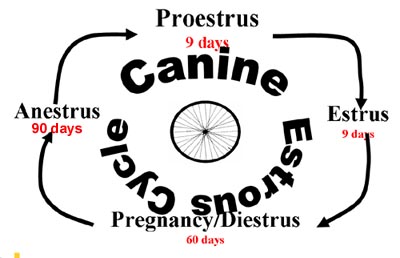
If you’ve been following, we’ve (and will be) mentioning heat cycle throughout this post. To ensure that we are on the same page, it’s important to understand the meaning of a heat cycle in dogs.
First thing first, most dogs go in heat when they reach puberty. In most cases, this occurs when they turn 6 months of age though it can vary depending on the breed and size of a dog.
Smaller dog breeds tend to reach sexual maturity earlier—sometimes even at 5 months of age. Larger dog breeds, on the other hand, may take up to a year to get their first period.
On average, dogs experience two heat cycles in a year. Again, smaller dog breeds may experience heat more often compared to their larger counterparts who may even experience it once every 18 months.
Typically, a heat cycle is divided into four stages:
1. Proestrus Stage
This is the first stage of a dog heat cycle and often lasts between 3 and 17 days. In most dogs, the stage lasts 9 days.
One of the most common signs of this stage is swelling of the vulva and bloody discharge from a dog’s vagina.
Other symptoms include a change in personality, tail tucking, and appetite changes (the dog may feel hungrier).
Again, the bloody discharge isn’t menstruation per se. As you can see, it happens before ovulation and before the female dog is sexually receptive.
Remember that menstruation in humans is due to shedding of endometrium in case pregnancy doesn’t occur. Dogs and cats reabsorb the endometrium instead of shedding it.
Bleeding at this stage is believed to be caused by diapedesis of the dog’s red blood cells due to an increase in estradiol-17β hormone.
2. Estrus Stage
This is the stage when the dog is fertile (actual heat). Her ovaries release eggs for fertilization.
The dog will be receptive to mating and tends to follow her natural instincts to breed.
Common symptoms in this stage include lightened discharge, softening of the vulva, and flirting (inviting male dogs towards her rear end).
3. Diestrus Stage
This is when the heat cycle concludes or comes to an end. The dog will be no longer fertile. It can last from 60-90 days.
In case the dog becomes pregnant, the stage will last from the end of estrus until the puppies are born (around 60 days).
Common signs of this stage are steady disappearance of vulva swelling and less flirting behaviors.
4. Anestrus Stage
Also referred to as the resting stage, this is the final stage of a dog’s heat cycle.
The female dog losses interest in males or becomes unreceptive to mating.
It often lasts between 100-150 days and at the end of it, the whole heat cycle starts again.
Related Post: How Long Does A Dog In Heat Bleed?
Do Dogs get Period Pains?

If dogs don’t experience the type of cramps that humans are familiar with, do they get period pains?
The short answer is: Yes, dogs do experience period pain. Past studies have shown that dogs have comparable neurotransmitters and neural pathways to humans. So, if humans feel period pain, there are high chances that dogs also do.
But a bigger percentage of canine experts agree that dogs don’t feel the same magnitude of period pains as humans.
However, it is still a challenge to reach such a conclusion considering that our pups cannot express their feelings verbally.
As with any other condition where pain is involved, the most important thing is to know whether or not your dog is pain during her periods.
To this end, here are a few signs to look out for:
- Excessive bleeding
- Shaking
- Twitching muscles
- Arching her back
- Lethargy
- Hanging her head, especially below her shoulders
- Excessive panting
- Restlessness
- Whining
- Sensitivity to touch or cuddle
- Unjustified aggressiveness
- Diarrhea or vomiting for over 24 hours
Given that any of these symptoms are hard enough to deal with in a human, they can be even worse in our pups because we often feel powerless to help them out.
So, if you notice any of the above symptoms during your dog’s heat cycle, contact your local veterinarian right away.
Related Post: My Dog Cries When He Gets Up After Lying Down For A While: What Does it Mean and What Can I do?
Do Dogs Get Period Cravings?
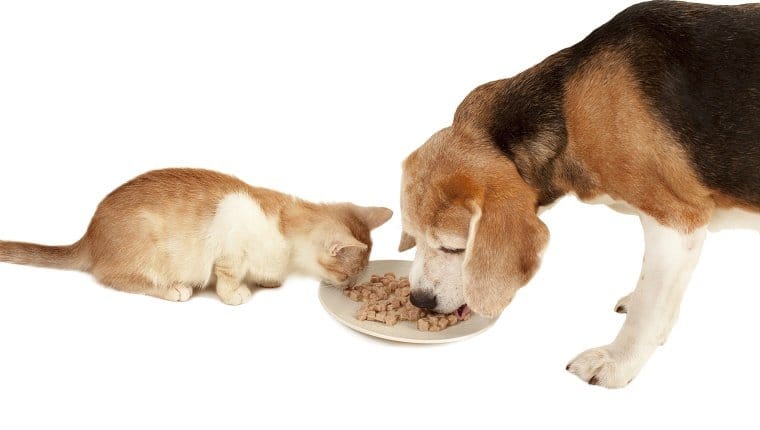
In humans, craving during periods is often blamed on hormones—changes in levels of estrogen and progesterone hormones.
Since dogs also experience hormonal imbalances during their periods, there are high chances that they experience cravings. Cravings may also be fueled by their need for comfort during this stage.
If you suspect that your pup is experiencing cravings during her periods, consider giving her frequent meals throughout the day to stabilize her blood sugar and prevent her from overeating.
Giving her some of her favorite treats can also go a long way in satisfying her craving. Just ensure that the treats are healthy and don’t trigger more period discomfort.
How to Relieve Dog Period Cramps
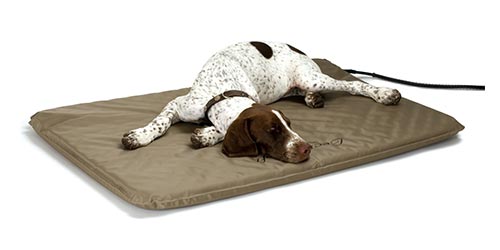
To help your pup go through her periods smoothly, you may need to go out of your way to ensure that she feels safe and comfortable. Here are a few tips that you can leverage:
I. Giver her aromatherapy massages
Aromatherapy massages (use essential oils) not only help muscles relax but are also great for promoting better blood flow.
They also relieve stress and boost the quality of sleep—which are critical for relieving period pains.
II. Apply a hot or cold pack
Applying a hot or cold pack on the stomach area or painful spot can also help the dog relax and get relief from period pains.
III. Give her favorite treats
Giving your pup some of her favorite treats is another excellent thing you can do to help her feel better.
In fact, some dogs may forget to eat while they are in their periods. So, ensure that yours is eating healthy and high-quality food.
IV. Give her CBD oil
In the recent past, CBD Oil has been prescribed to dogs as a painkiller. You can also try it if you realize that your dog is in pain during her heat cycle.
Like any other medication, it is important to consult your vet before using CBD oil on your dog.
V. Natural Remedies
Ginger root supplements, herbal teas, valerian, and turmeric are a few natural remedies that can help to ease your dog’s discomfort.
As usual, talk to your vet before trying any natural remedy on your Fido.
VI. Give her off-the-shelf pain relievers
If you feel that your dog is really in pain, you can consider off-the-shelf pain medication—of course with the vet’s approval and instruction.
Pain medications can cause a host of health issues in dogs, so ensure that everything is done right.
VII. Get her spayed
The only way to prevent period pain and to stop wondering whether or not your pup is experiencing period cramps is to get her spayed.
Spaying will stop her heat cycle entirely and comes with a host of benefits as well, including:
- No discharge, which translates to less cleaning for you.
- It can deal with certain behavioral issues that you may have dealt with if she wasn’t fixed.
- It also prevents a wide range of health conditions, including several types of cancer.
- Spayed females live longer than their unspayed counterparts.
What Do You Do When Your Dog Gets Her Period?
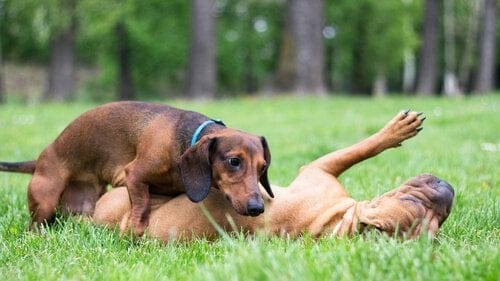
Another common concern, especially among first dog owners is how to handle the situation when a dog gets her period.
Getting her period for the first time can be a confusing experience for your girl, and it is vital to understand how to help out.
Without further ado, here are a few things that you can do:
A. Give her love and support
Some dogs may feel more snuggly than usual during their periods. If yours fall in this category, consider giving her more attention and love than you normally would.
Let her cuddle freely with you and even sleep on the bed with you if possible. If you are worried about her leaving discharge on you or your blanket, consider putting her in a diaper or surgical suit.
And if she makes a mess, don’t scold her. Instead, reassure her and don’t let her know that you are angry.
B. Strike a balance between rest and play
I bet you don’t want to play or exercise when you are in pain or experiencing cramps, neither does your pup.
Accordingly, strive to strike a balance between rest and play. Let her guide you with regards to what she is up to.
C. Avoid off-leash walks
First things first, taking your dog out when she is on her period is not a good idea because she will easily attract male attention and you know what that means— puppies in about 3 months.
If you have to, stay close home and put her on a leash always—even if you consider her well trained. No amount of obedience training is more powerful than natural instincts.
Related Posts:
What Does A Dog In Heat Smell Like?
D. Get her female diapers
As hinted above, if you don’t want your pup’s discharge on the floor and your furniture, getting her female dog diapers is highly recommended.
Nowadays, there are even reusable options for economically or environmentally conscious dog parents.
Check out this post for excellent options: 10 Best Dog Diapers for Periods
E. Consult a vet
I know that being in heat isn’t a big issue but having a chat with your local vet about abnormal signs that you may have noticed during this period or how to take care of things may go a long way in helping you handle the unexpected.
There are also symptoms that could indicate serious illnesses, which makes talking to your vet even more worthwhile.
Parting Thoughts
So, do dogs get cramps on their periods? Probably—but not ‘cramps’ in the real sense of the word!
All in all, while we cannot be certain whether or not a dog in heat get cramps, assuming that it is a possibility can afford us the opportunity to help our dogs remain calm, relaxed, and comfortable during this period.
That being said, indulge your dog a bit during her periods to help keep her calm and quiet.
Give her a few extra treats or special toys as well as some additional one-on-one time to comfort her.
Related posts:
As an Amazon Associate, we may receive a small commission from qualifying purchases but at no extra cost to you. Learn more. Amazon and the Amazon logo are trademarks of Amazon.com, Inc, or its affiliates.

